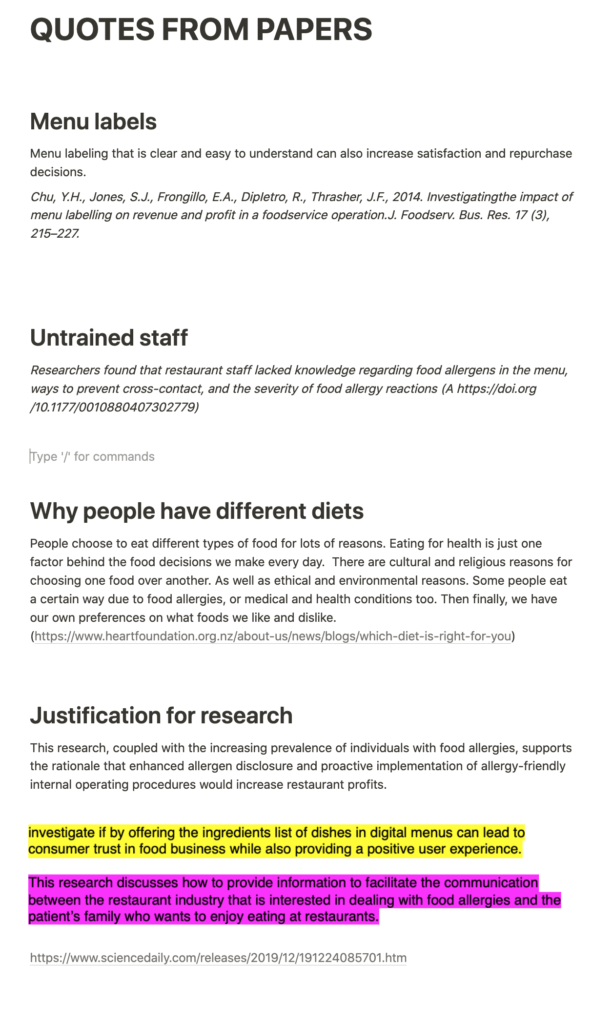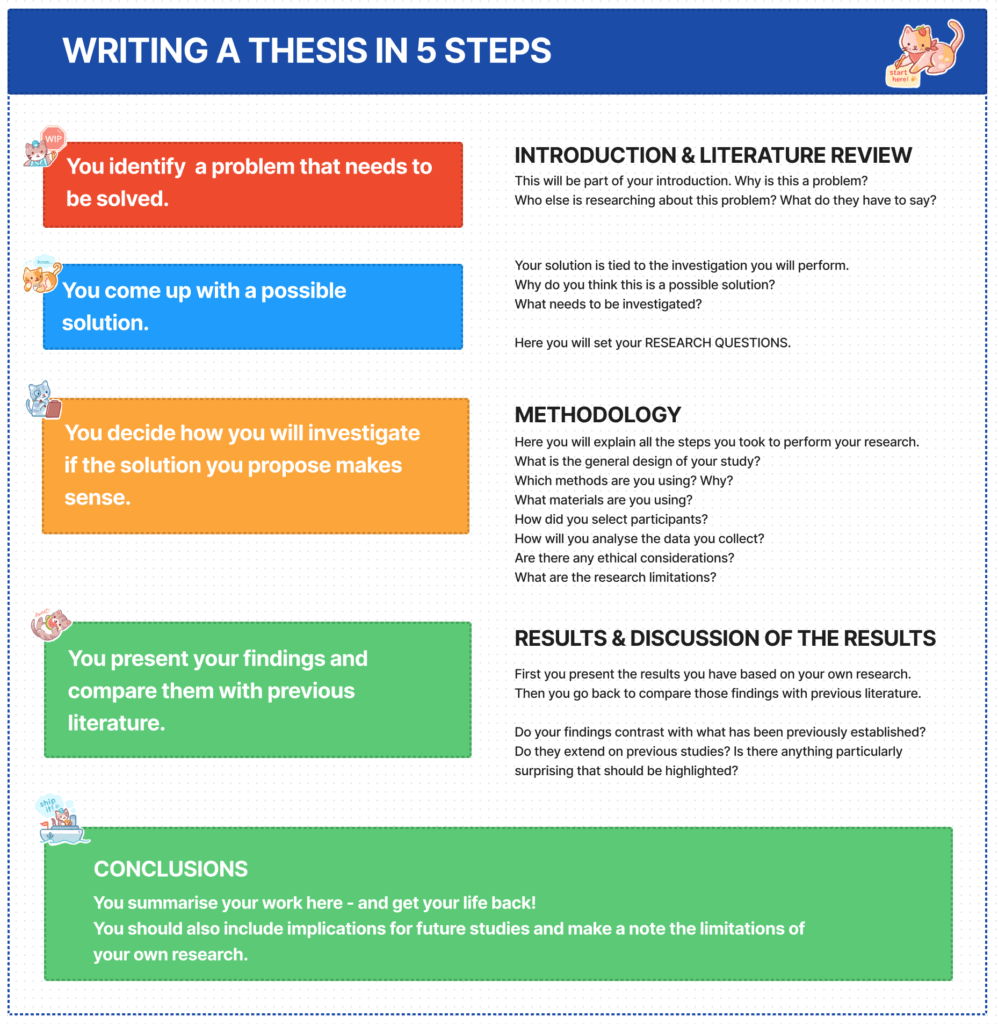Writing a Master’s thesis is not an easy task… When I was going through the process, it often felt that the step I was performing at the moment was the hardest. It started with the choice of a topic. When the subject was chosen, I thought, well, that was the most challenging part; now I can move on… Little did I know that there was no easy part in it, really! But in the end, I believe such an accomplishment will indeed push you to grow professionally and personally.
So here I put a list of useful websites and tools that can help you along your journey. Additionally, I can’t emphasize enough the importance of organisation along the way. You will come across many articles, and many sources, and you need to have a methodic way of working so you don’t overwhelm yourself. So I will share some organisation tips that worked for me, as they could be helpful for you too.
Lastly: Brace yourself, it will be challenging, but you will make it!

[ update 2013 ] While ChatGPT can help you, I didn’t have access to it when this article was created, or working on my thesis. So you could still use some of these tips 😉
Part 01: Picking a topic
You will have to go through this step if you are not lucky enough to have a topic in mind when you start your programme (I think most of us aren’t!). A couple of things you can do here:
- Follow industry blogs on topics that you are interested in. Websites such as TechCrunch and TrendHunter are great for following general innovation trends.
- ProductHunt is great to be inspired about new digital products (some are great, some not so much, but all of them have some sort of innovative aspect and possibly could have been presented by a Media Innovation graduate).
- IdeasGrab is where you will find many useless ideas but some funny ones that can inspire you.
- Google is your friend! You can search for something like “Ideas for Master Thesis in Media Innovation”, and you will find links to discussions on sites like Quora and Research Gate, which can give some interesting pointers.

** Master tip
- Try to define well the problem you are trying to solve and investigate. This will help you narrow down your research question and make it easier to find related literature. The “5 Why’s Technique” can be very useful in this regard. It is also useful to follow the Design Thinking principles for setting the problem, the goal, and moving on to formulating a hypothesis based on how you might solve the problem (Method How Might We).
- For every academic article you read, there is a section at the end with the study limitations and recommendations for future research (and you will have to read a lot of them! ????). These can be a starting point for you!
- Create an account “somewhere” that you can access with your phone, tablet, desktop, laptop, and every device you use. You can use anything, like a folder in Google Drive with some documents or websites such as Notion or Evernote. It is crucial that the app is easily accessible because you will have ideas coming to you when you are doing things completely different than thinking about your thesis (and when ideas are not written down, they fly away!). If something pops up in your mind, write it down there!
- When you have enough ideas, reserve some time to make some sort of mindmap and try to see what these ideas have in common. From there, pick 2-3 more interesting topics, and start reading related articles. It will likely be a long process of reading, writing new ideas and discarding old ones. I used to download many articles at once, put them in a folder named “TO READ”, and move them to another folder “READ”, once I finished. I also used coloured tags for representation (for example, GREEN = good article, likely to be used; YELLOW = not so related to what I wanted, but could still be useful; READ = not related, but I can use the structure for inspiration when I am writing).
- Once you have a good direction, for every article that you read, highlight parts that can be used in your text. I liked to do this by copying the pieces of text to a document, separated by topic (see the following image for an illustrated example). Important: Keep the reference, such as the DOI or URL, for every fragment you saved because you will need to reference them! I found out that using the DOI is the easiest way to work, as tools like Scribbr have an excellent reference generator and make things easier for you!

Part 02: Writing your thesis
You have a topic, great! Now you ONLY have to start writing the thesis ????. Here I will skip tips on the structure of your document itself (there are many references online that can tell you better than I, and you will have some guidance during your studies on that too). Therefore, here are some websites that helped me with the writing itself and what they do.
- Sci-Hub: Download academic publications for free.
- Z-Library and PDF Drive: Download books for free.
- Academic Pharasebank: This is a must! It helps you write academically and formally. It is very helpful, especially when you are not a native English speaker (like me!).
- Grammarly: Another must (at least for me!). This is an app which can support you tremendously while writing. It not only fixes mistakes but gives tips on how to improve your sentences, fixes grammar issues, and can also check for plagiarism (very handy when you forget to note down the reference!). It is really worth it paying for the premium; it will be useful in any assignments you submit (in fact, I am still using it, even as I write this post!). Extra tip: You can get a discount via ISIS: https://www.isic.org/discounts/
- Powerthesaurus: This is one of my favourite web dictionaries for synonyms. You will need to talk about your topic repeatedly, so using different words makes the text more pleasant to read. Likewise, Quillbot can help you, as it can be used for rephrasing whole sentences. Be mindful not to use paraphrasing tools to copy the work of others; this is illegal! You can always reference previous work, so no need to be a copycat.
- Scribbr: I ❤️ Scribbr! Honestly, it would be a pain in the ass to organise all the references if Scribbr didn’t exist. I suggest you create an account and keep all your references there.
???? Master tip on references
Managing references while you write can become messy. So to keep things clean while I was writing, and also not to disturb my creative flow, I decided to keep a “REFERENCE DRAFT” in my working file, and just put every reference there, unformatted, with a number. Later on, when my document was finished and the text was revised, I went back and fixed all the references, using Scribbr for complying with the APA format.
So, for example, in the following paragraph, I would write like this:
The issue is even more prominent with online menus, as communication with the food establishments is more challenging than in-person (ref 01). Thus, individuals are left responsible for researching meals that accommodate their diet needs, unnecessarily reducing their food options or leading populations with health conditions to take avoidable risks (ref 02; ref 03).
Keeping in my REFERENCE DRAFT something like this:
[1] https://doi.org/10.1371/journal.pone.0156073
[2] https://doi.org/10.1080/13698575.2017.1333088
[3] https://doi.org/10.1111/j.1365-2222.2010.03649.x
With this way of working, I also made sure all the references in the final reference list appeared in the text. You might find this way of working great, or you can be more efficient in your own way. There is no right or wrong, as long as you make sure everything has the reference in the APA style ????
Part 03: Designing and running your experiments
You will learn much about quantitative and qualitative research methods during your course. I will not cover details of methods here, but instead share practical tips I have in this regard.
Using Qualtrics to run your survey? This list of hacks can have something useful for you.
Need people to answer your survey? You can try Facebook groups for survey exchange, like this one. There are also websites where you can swap answers. Two popular ones are SurveySwap and SurveyCircle. Reddit is also a place where you can look for participants. But make sure you have a balance between where you source for replies. It is very important that you also approach people that are not necessarily working in research themselves so that you can have a good mixed sample. In my case, I printed some papers, had a beer 🙂 (to feel less shy!), and approached people in the library, the train, and snack bars.

Survey design is a very important step! Among many other directives that you should follow, I will highlight three here. First, prefer to use values instead of bins (you can always bin the values later!). For example, instead of asking people about their age range (in terms of 30 – 39), have them type the value (for example, I’d type 31).
Secondly, avoid having to do a manual classification with the responses or ask people to confirm what you need to know with some sort of tickboxes to avoid deleting data for the lack of certainty of what they mean. This tip comes as a point of improvement from my own research. I had to classify the type of diet people follow under three directives. I thought it would be too complicated for the research participant to categorise their diets themselves, so I opted to have an open field where they could disclose their diet limitations, followed by my manual classification afterwards. However, this choice was not optimal as I had to disregard many responses due to the unclarity of the text. I could have improved the design of my survey by keeping the open field but also asking the participant to confirm if their diet fit in one or more of my classification groups.
Thirdly, ensure people are paying attention to what they are replying to (also known as Acquisience Bias). You can do so in several ways. For example, you can include a question in the middle of your survey that clearly states something like “click in option A, to make sure you are paying attention“; you can add a reversed item in your scale; you can ask people to type a certain quote in an open field. This is important to show reliability and credibility. After, you will need to perform a Cronbach’s Alpha test (nothing to worry about here, check the next part with links to tutorials 😉 )
Finally, ideally, when you design your survey, you know which statistical tests you have the intention to perform (or at least have a strong idea). In practice, you might need to change the tests later (in case you don’t have a normal distribution, for example, or a very small sample for a sub-group), but it is better to do that than to shoot in the dark. Here you can find a terrific list of which statistical tests to use, including examples in SPSS, R, STATA and SAS. Scribbr has a similar article, with more explanatory text but lacking examples.
PART 04: Data Analysis – QUANTITATIVE (Statistical ANALYSIS)
Now we are talking about the fun part! 🙂 Here I compiled a list of websites that helped me with the statistical analyses.
- SPSS Tutorials: Most of what you need to do in SPSS for your research can be found there.
- University of Lincon SPSS How To Guides: Self-explanatory. It’s a good complement to the link above. Great chances you won’t need anything else to help you run your tests.
- To report statistics in an APA format, you can check this PDF. Additionally, it is always nice to check in other academic papers how they report, as you can follow a similar format in your own research.
- Quantitative User Research: This is a compilation of several articles related to quantitative user research. Maybe not so useful during your thesis, but certainly during the other assignments.
- Likert scales! I’d place a bet you will be using them 🙂 There are a thousand+ questions on forums about how to interpret Likert-scale data. So, to make things even easier for you, here is what you can do:
- If a scale is composed of three or more similar Likert-type items, you can use the mean as a central tendency – or, you can calculate the average to measure what you want (the reference from this comes from de Winter & Dodou, 2010 – https://doi.org/10.7275/bj1p-ts64).
- If you want to learn more about Likert scales, you can read this article: https://www.statisticshowto.com/likert-scale-definition-and-examples/
PART 05: DATA ANALYSIS – QUALITATIVE (THEMATIC ANALYSIS)
If you are running a Thematic Analysis under your qualitative research, chances are you are coming across research from Braun and Clarke. Next, you can find some references for your study. Additionally, this document has a step-by-step guide that is very useful.
- Braun, V., & Clarke, V. (2006). Using thematic analysis in psychology. Qualitative Research in Psychology, 3(2), 77–101. https://doi.org/10.1191/1478088706qp063oa
- Braun, V., & Clarke, V. (2016). (Mis)conceptualising themes, thematic analysis, and other problems with Fugard and Potts’ (2015) sample-size tool for thematic analysis. International Journal of Social Research Methodology, 19(6), 739–743. https://doi.org/10.1080/13645579.2016.1195588
- Braun, V., & Clarke, V. (2021). Thematic Analysis: A Practical Guide (1st ed.). SAGE Publications Ltd.
More master tips ****
Finally, make sure you have a consistent story throughout your document. Writing a thesis also requires storytelling skills, albeit with an academic flavour. Assume people have little previous knowledge of the topic before reading your paper, so explain the terms and include references to previous work. Do not come out with “things out of your head” without explaining the reasoning.
Lastly, it is a good practice to write a brief introduction and conclusion at the start and end of every section. For example, at the beginning of your literature review, reserve the first paragraph as a glimpse of the sub-sections to come. Likewise, make a connection at the end of the section with the following chapter. It might feel like unnecessary repetition, but it contributes to creating a concise story for readers, who might also skip between chapters as they might be more or less interested in certain aspects of your research.
And remember: You got this! 🙂 To finish, I leave you with a quick schema of how your study could be structured. And in here you can see how I approached my own research (I did something right because I graduated cum laude <3 )
And, in case you need it, feel free to contact me at hello@imgabi.com

